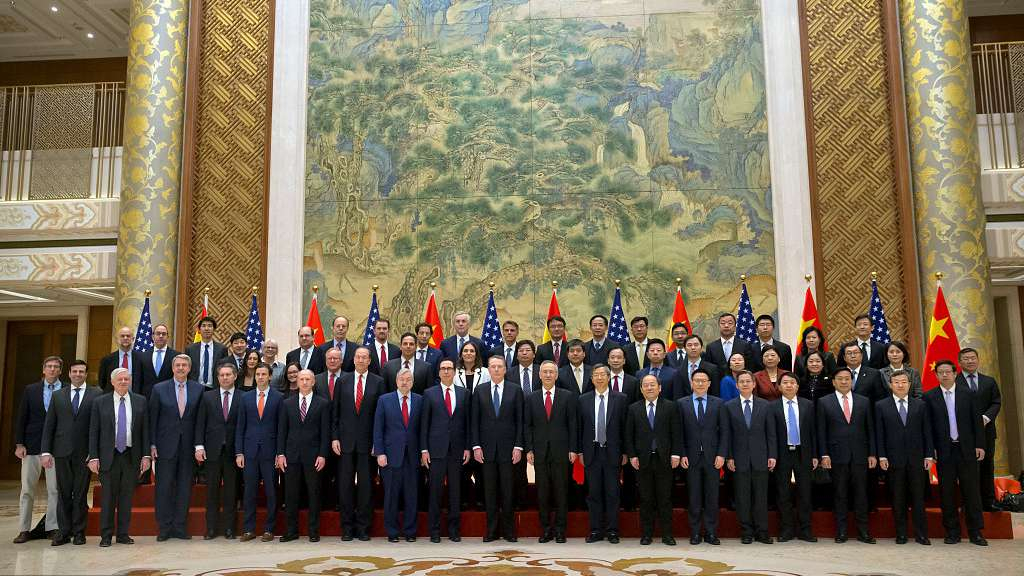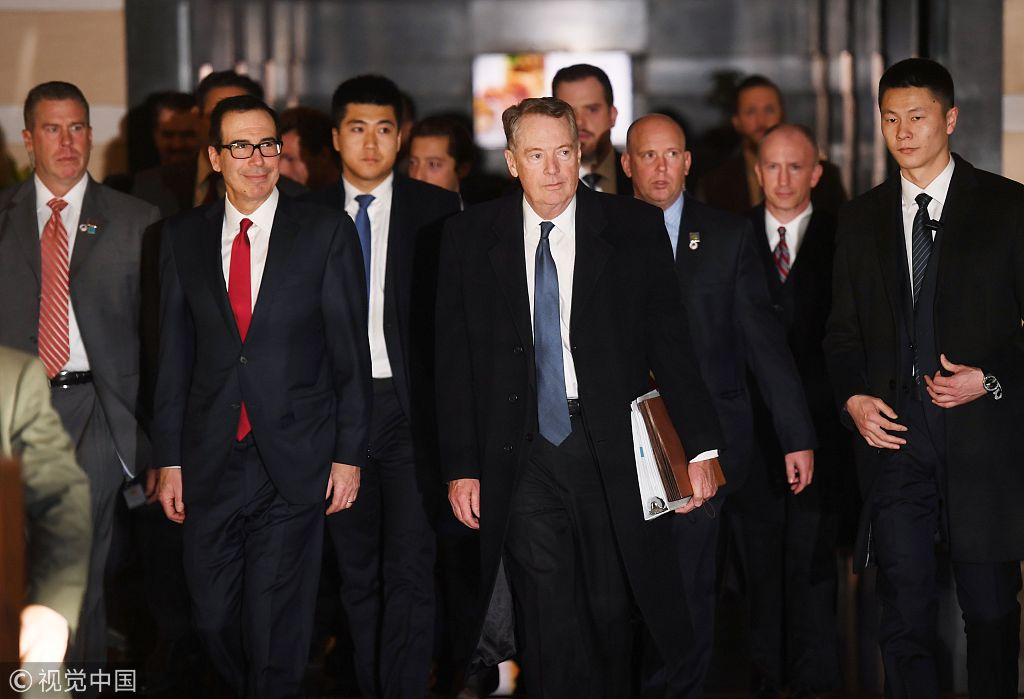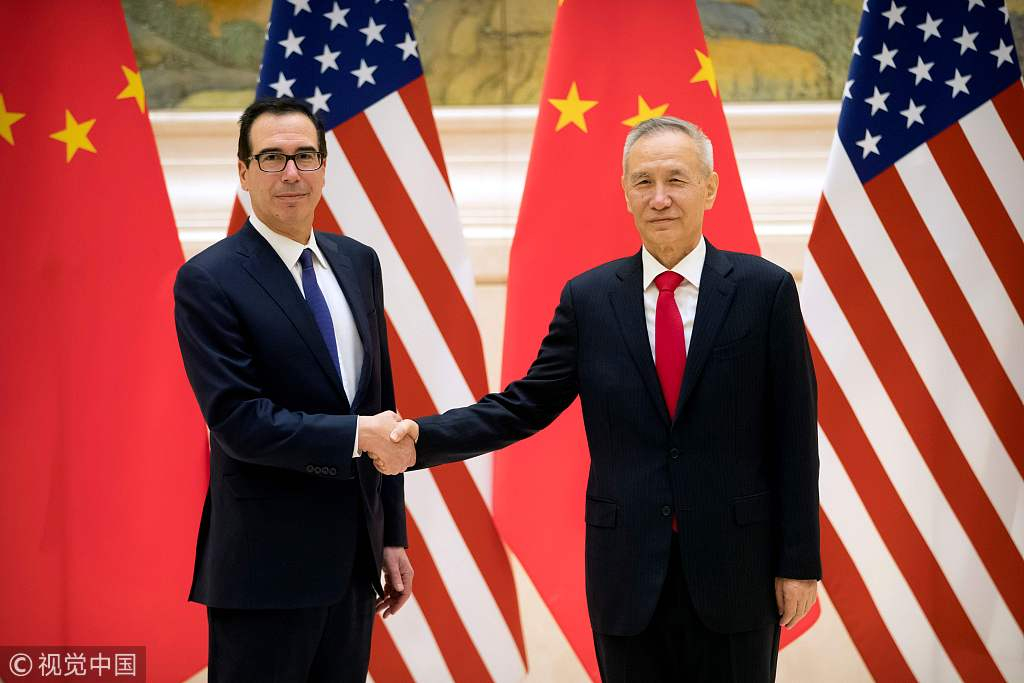
Analysis
15:07, 18-Feb-2019
China is on its own way to a better future

Editor's note: This article is an edited translation from an analysis originally published in Chinese on China Central Television (CCTV) on February 16.
On February 15, the sixth round of China-U.S. high-level economic and trade negotiations ended in Beijing. Liu He, chief of the Chinese side of the China-U.S. comprehensive economic dialogue, U.S. Trade Representative Lighthizer and Treasury Secretary Mnuchin led teams to hold a new round of dialogue on top of previous negotiations in Washington DC.
China and the U.S. reach consensus in principle on major issues at the economic and trade talks
During the two days of negotiations, both sides earnestly implemented the consensus reached at the Argentina meeting between the two heads of state, and had in-depth exchanges on issues of common concern such as technology transfer, intellectual property rights protection, non-tariff barriers, service industry, agriculture, trade balance, implementation mechanism and other issues of concern to China. The two sides reached a consensus in principle on major issues and held specific talks on the memorandum of understanding on bilateral economic and trade issues.
As a matter of fact, since the China-U.S. summit on December 1 last year, especially since late December last year, the two sides have been contacting each other more often, and the size of U.S. delegation has grown bigger. The last round of China-U.S. high-level economic and trade negotiations ended in Washington DC on January 31, right before the Chinese Spring Festival.

U.S. Treasury Secretary Steven Mnuchin (front L) and U.S. Trade Representative Robert Lighthizer (front R) leave a hotel on the way to trade talks in Beijing on February 15, 2019. /VCG Photo.
U.S. Treasury Secretary Steven Mnuchin (front L) and U.S. Trade Representative Robert Lighthizer (front R) leave a hotel on the way to trade talks in Beijing on February 15, 2019. /VCG Photo.
On the first day after the Spring Festival holiday, the U.S. negotiating team came to Beijing to engage in this round of negotiations. For both Washington and Beijing, such close and frequent interaction and communication only shows one thing: both sides are doing their best to push forward the implementation of the important consensus reached at the Argentina meeting between the heads of state of China and the United States and push things towards mutually beneficial results.
According to Zhu Min, former vice president of IMF and director of Tsinghua University National Institute of Finance, talking is a good thing.
There are many details involved in the trade talks. Both sides are working towards reaching positive results and agreements. However, there will also be differences but they don't matter. To do trade, there has to be negotiations. It's good as long as both sides talk to each other. The U.S. side is also increasingly aware of the need to resolve this issue through negotiations, so both sides are having increased number of talks, which is a good thing.
- Zhu Min
There is no doubt that this round of negotiations is the most important one in the China-U.S. arm-wrestle over the past year. Both sides attach great importance to it and hope to make breakthroughs. The pressure is high. On the evening of the 14th, both sides worked all night long with great diligence, dedication and professionalism for the sake of their national interests.
Hard work always pays off. After the talks, Chinese President Xi Jinping met with U.S. Trade Representative Lighthizer and Treasury Secretary Mnuchin in the Great Hall of the People. This is the first time that a Chinese head of state met with U.S. trade negotiators since the beginning of China-U.S. trade dispute last March. This undoubtedly sends a very positive signal: China and the United States have taken another step towards resolving the trade dispute on top of the negotiations in Washington.
This is a very good signal. Earlier, President Trump received the Chinese Deputy Prime Minister in the United States. Judging from the action of the two governments, both are trying to reach an agreement.
- Jarrett
Identify the greatest common denominator
Seeking common ground while shelving differences is a basic consensus between China and the United States in solving bilateral issues.
President Xi Jinping pointed out during his meeting with U.S. Trade Representative Lighthizer and Treasury Secretary Mnuchin on the 15th, “I have said many times that neither China or the U.S. can live without the other. We are better together and worse if we fight each other. Cooperation is the best choice. As for the economic and trade disputes between the two countries, we are willing to resolve them through cooperation and push for an agreement acceptable to both sides. Of course, there are principles for cooperation.”
Liang Ming, Director of the Foreign Trade Research Center at the Chinese Academy of International Trade and Economic Cooperation, said that after many rounds of negotiations, despite that there are more consensus and fewer differences than before, contradictions still exist. It is unrealistic to settle trade disputes between the world's two largest economies just through several rounds of negotiations.
For example, on some structural issues, there remains to be some differences between China and the United States. These are the issues that China and the United States need to resolve through consultation in the next step. Perhaps the next step is for both sides to identify the greatest common denominator, find common interests, and further promote the healthy development of China-U.S. economic and trade relations through consultation.
- Liang Ming
The key is to play on the one string we have.
Of course, things are moving in a good direction, but the China-U.S. trade friction that has lasted for nearly a year has increased the uncertainties in the world. In the view of Minsoo Lee, head of the Economics Unit of the PRC Resident Mission of Asian Development Bank, China has nothing to lose.
Trade friction has both negative and positive impacts on China. We need to take a long view on which one is more profound. Tariff changes often have short-term impact and very limited impact in the long term. In the long run, it can spur China to further open up the economy and push forward the structural reform on the supply side, and gradually solve some of China's problems. This is an opportunity for China. There is a Chinese proverb called “opportunities and challenges coexist”. If you have challenges, you can turn them into opportunities. This trade dispute serves as a good lesson for China. In fact, China has nothing to lose.
- Minsoo Lee
There are always traces of history that follow in reality. In an interview with the media at the end of last year, Kenichi Ohmae, a well-known Japanese business strategist and a management guru, said that since the 1970s, Japan has been the country with the most prolonged and frequent trade disputes with the United States.

U.S. Treasury Secretary Steven Mnuchin (L) and Chinese Vice Premier and lead trade negotiator Liu He shake hands as they pose for a photo before the opening session of trade negotiations at the Diaoyutai State Guesthouse in Beijing on February 14, 2019. /VCG Photo.
U.S. Treasury Secretary Steven Mnuchin (L) and Chinese Vice Premier and lead trade negotiator Liu He shake hands as they pose for a photo before the opening session of trade negotiations at the Diaoyutai State Guesthouse in Beijing on February 14, 2019. /VCG Photo.
Be it a dispute over fiber, clothing, wood and shoes, or a dispute over steel, tire, TV, car and even telecom and semiconductors, every time seemed to end with Japan's retreat and compromise, but in fact it has brought countless benefits to Japan, making Japanese-made products better in quality and its processing and trade more globalized. As a result, the market economy in Japan has become better established.
As a matter of fact, as for some structural issues over what differences are between China and the United States, such as intellectual property rights protection and non-tariff barriers, if you look at the decision of the Third Plenary Session of the 18th Central Committee of the CPC on several major issues concerning the comprehensive deepening of reform and the report of the 19th National Congress of the CPC, you can find that China intends to address these structural issues in its bid to reform the economy.
Only by addressing these issues can China realize high-quality economic development and continuous improvement of its overall national strength. So it's not a convenient action for China to address these issues now in exchange for less external pressure.
As for the results of the consultation, if you look at it with a long view, today's results, whatever they are, are not important. The important thing is, no matter how big the external problems are, we only need to play on the one string we have. As Lu Mai, Secretary-General of the China Development Research Foundation, said, China is on its own way and it can surely go down this way to a better future.
Everyone is looking forward to reducing the uncertainties, but it will take some time to reach a final result. In a word, there is still a long way to go, but China is on its own way, and it can surely go down this way to a better future.
- Lu Mai
(If you want to contribute and have specific expertise, contact us at opinions@cgtn.com.)

SITEMAP
Copyright © 2018 CGTN. Beijing ICP prepared NO.16065310-3
Copyright © 2018 CGTN. Beijing ICP prepared NO.16065310-3